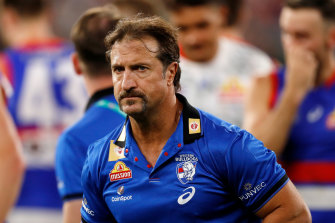Week one of the 2022 AFLM season has exposed the frailties in AFL workplace and media cultures and highlighted the fault lines in their claims to safe and inclusive communities.
A short recap: Part One. In the nationally televised press conference that followed the round one match between Melbourne and the Western Bulldogs, Luke Beveridge, coach of the Western Bulldogs, launched an excoriating tirade against the Fox Sports journalist Tom Morris. Widespread condemnation of Beveridge followed, inspired in large part by his attack on a journalist considered to be doing his job. Beveridge and the Western Bulldogs issued an apology the following day.

The response to Luke Beveridge’s commentary about a woman journalist exposes a double standard in AFL.Credit:Getty Images
Part Two. In the same media cycle, an unknown source leaks a WhatsApp recording of Morris’ crude, objectifying, heteronormative commentary about a female colleague and journalist at Fox Sports. There was arguably less initial outrage, despite the woman being parodied and paraded, both by Morris’ comments and the leaking of them. She was presumably also doing her job. Morris, who apologised, was initially stood down and later sacked by his employer.
So what does all this tell us of the workplace and media cultures that characterise the administration and reporting of Australian rules football? There are multiple workplaces and entities involved. In this particular instance, the AFL as the sport’s administrator, the Western Bulldogs as a club, and Fox Sports as a media organisation. And to be clear, neither Beveridge nor Morris are direct employees of the AFL’s administration. But the boundaries aren’t so clear.
The AFL’s own media unit is a significant stakeholder in the game’s media landscape. There are preferred media outlets by way of contracted broadcasting rights. Conflict of interest is rarely addressed with any real scrutiny, and there are multiple instances of media personalities who also hold positions as either club football directors, advisers or presidents. So the boundaries are blurred and the capacity for coherent and well-informed analysis and scrutiny becomes limited. The industry is simultaneously cosy, brittle and resistant to critique.
Loading
In this culture, particular tropes flourish. One is the significant regard for a closed brotherhood which is at best too forgiving of fraternal transgressions, and at worst prone to toxic masculinity. The second is the muscular hostility to scrutiny and any challenges to the shibboleths of the AFL as privileged through the sport’s hegemonic cultures. This is the context that resists and renders partial much-heralded diversity and inclusion reforms. This helps explain the gulf between the noteworthy policy advances made by the AFL, clubs and media organisations, and the realities of aspects of the sport’s practice. Thus, Morris’ cringeworthy views arise from the cultural entitlement afforded to his world view.
As a sport, the AFL has previously faced questions about the strength of its commitment to diversity and inclusion. The treatment of Adam Goodes, hounded from the game by racism, and Caroline Wilson, the target of entrenched sexism, are cases in point. These and others have frequently, although not exclusively, followed a predictable pattern of four overlapping stages: the denigration of the cultural outsider, the dismissal of the denigration as harmless banter, an apology of sorts and sanction amid an unclear commitment to reform, followed by a backlash, perpetrated by the sport’s praetorian guards against the outsider.
Loading
In the case of Morris, the sanction has fallen, and he has lost his job. And the commitment to reform? A woman’s safety and her professional well-being has been shockingly compromised. Any claim by the organisations involved to uphold diversity and inclusion need to come up with more than platitudes about some all too evident and endemic shortcomings.
Meg Smith is an associate professor in the School of Business, Western Sydney University








